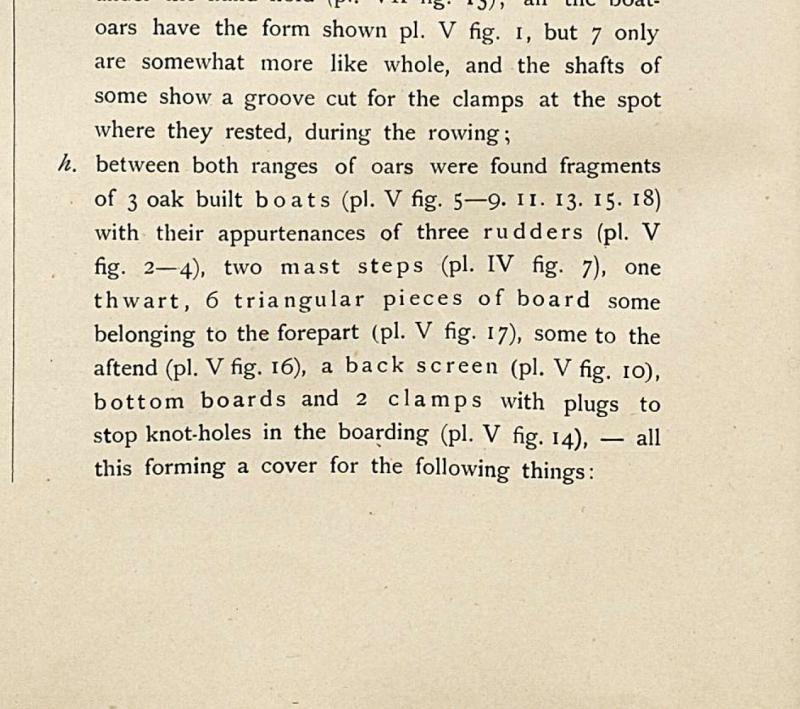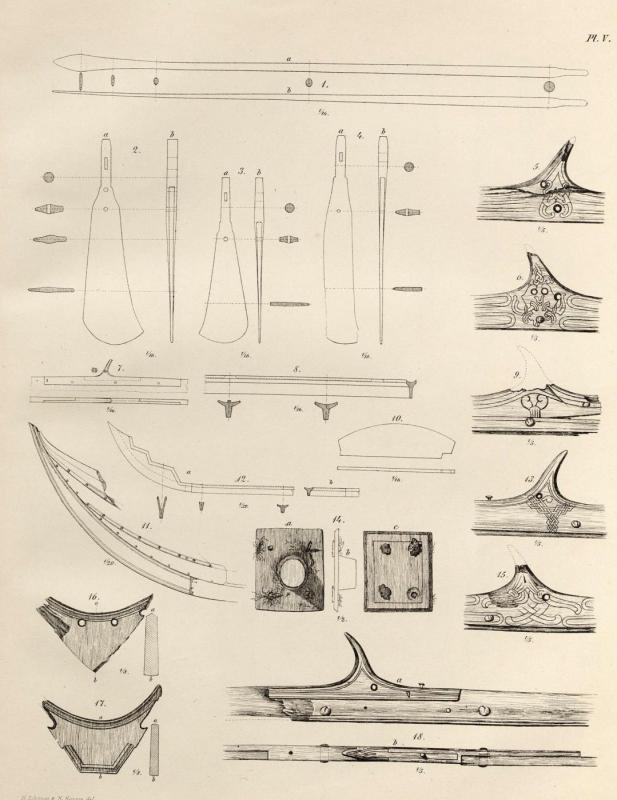-
Posts
1,268 -
Joined
-
Last visited
Content Type
Profiles
Forums
Gallery
Events
Everything posted by jack.aubrey
-

Italian Boats of the Adriatic Sea
jack.aubrey replied to jack.aubrey's topic in Nautical/Naval History
Italian Boats of the Adriatic Sea The Pielego Cherini/32-Pielego_zpsjajq7zgz.jpg Cherini/pielego_zpsq6eh3ofp.jpg The pielego was a smaller version of the trabaccolo and was commonly used in the middle and upper Adriatic. It became even more popular than the trabaccolo because its better flexibility. Disegni da http://www.cherini.eu/ -

Italian Boats of the Adriatic Sea
jack.aubrey replied to jack.aubrey's topic in Nautical/Naval History
Italian Boats of the Adriatic Sea The Trabaccolo Cherini/31-Trabaccolo_zpsglcjhtyg.jpg Cherini/Piccolo trabaccolo 1910_zpsffc0gq8r.jpg Pictures by http://www.cherini.eu/ The trabaccolo is a Venetian sailing coaster, built of oak and larch, that dates back to the 15th century, and which became widespread all over the Adriatic. The name derives from the Italian word trabacca, meaning “tent” – a reference to the vessel's sails. The trabaccolo was used as a cargo vessel, and generally had a crew of about 10 to 20 sailors. In the 18th and 19th centuries many of these vessels carried cannons in order to defend themselves from Muslim and Slavic pirates, and from French and British privateers cruising around the coast of Italy, who frequently attacked and pillaged these ships. The Maritime Museum of Cesenatico in Emilia-Romagna, Italy has a newly-restored, original and fully functional trabaccolo. -
Italian Boats of the Adriatic Sea The Brazzera Cherini/126-Brazzera con vela al terzo_zpsrcoxa9nk.jpeg Cherini/33-Brazzera_zpsb8kofcxg.jpg Cherini/34-Brazzera a 2 alberi_zpshyybxcdc.jpg Pictures by http://www.cherini.eu/ The brazzera (called bracera in Croatian) is a traditional Italian cargo sailing vessel which originated in Dalmatia, and was first mentioned in the 16th century. It derives from the Italian expression forza di braccia, meaning “power of hands” (which the Venetians called brazzi) because the vessel was moved by oars. These vessels were often designed with a lateen rig (also known as a Latin rig) – a triangular sail invented by the Romans. The brazzera was widely used all over the Italian coastal region of Dalmatia, as well as in Istria and the Gulf of Trieste by Italian sailors and fishermen. They were often used to transport wine, olive oil, salt, sand, wood and other supplies. In Istria the brazzera was especially utilized in the Italian cities of Rovigno, Pirano, and Capodistria. In Dalmatia they were widespread all over the entire coast, but most notably in Ragusa and the Venetian island of Brazza. In the last few decades a conscious effort has been made by Croatian writers and organizations to misappropriate the brazzera and proclaim it a “Croatian” vessel and pretend that it belongs to “Croatian” culture and tradition, once again usurping the heritage of Istria and Dalmatia and forging a new Croatianized revision of history. Croatian nationalist editors have used Wikipedia to create articles depicting the brazzera as a “Croatian” vessel. In 2006 the Dolphin Dream Society, a Croatian environmentalist organization founded in 2001 in Zagreb, even launched a national campaign known as “The White Project” aimed at conserving traditional “Croatian” shipbuilding and “Croatian” maritime heritage. As part of this project, in 2011 the Dolphin Dream Society constructed a replica or imitation of a traditional 18th century brazzera with a Latin sail, which they named Gospa od mora (“Our Lady of the Sea”). Today the Dolphin Dream Society operates an education program designed to teach Croats how to continue “their” tradition of crafting brazzera vessels. The Dolphin Dream Society also operates an art program in collusion with the Croatian tourist industry, using stolen heritage, occupied land, and a falsified history to generate tourism and stimulate the Croatian economy. Cherini/19-Brazzera istriana vecchio tipo_zpsks2vd71c.jpg Cherini/18-Brazzera veneto dalmata_zps671g8ml7.jpg
-
Interesting article where it is supposed, by archeologist discovery, that Vikings went quite far, in the north american land, than Vinland . . . http://worldnewsdailyreport.com/usa-viking-ship-discovered-near-mississipi-river/
- 170 replies
-
- gokstad
- dusek ship kits
-
(and 1 more)
Tagged with:
-
Thank you all for the kind words and the likes, I appreciate very much! Jack.
- 170 replies
-
- gokstad
- dusek ship kits
-
(and 1 more)
Tagged with:
-
Tuesday, September 20th, 2016 The finished model with the complete display case . . . Now this model can be really considered a closed project. It was a very interesting and valuable experience: the clinker planking, the viking culture and many other things. Enjoy the attached images . . . bye, Jack. 01 20160919_175003.jpg 02 20160919_174931.jpg 03 20160919_174915.jpg 04 20160919_180158.jpg 05 20160919_174840.jpg 06 20160919_174812.jpg 07 20160919_174738.jpg 08 20160919_180251.jpg 09 20160919_180237.jpg 10 20160919_175012-EFFECTS.jpg
- 170 replies
-
- gokstad
- dusek ship kits
-
(and 1 more)
Tagged with:
-
Added the rudder and some other small details . . . now a coat of clear matt paint and then it's time to proceed with the second boat . . 01 Brick%20by%20JackAubrey/20160916_205406_zpslqmygcaw.jpg 02 Brick%20by%20JackAubrey/20160916_205713_zpsrj5hzvd6.jpg 03 Brick%20by%20JackAubrey/20160916_205348_zps4g1zac0d.jpg
-
Monday, September 12th, 2016 A new step in adding details to the longboat . . it is a very interesting, amusing and relaxing task, provided your have a lot of patience . . 01 Brick%20by%20JackAubrey/20160912_122945_zpsqxbrqec1.jpg 02 Brick%20by%20JackAubrey/20160912_123156_zpswnwq1wru.jpg 03 Brick%20by%20JackAubrey/20160912_123209_zpsdnxjpyvp.jpg 04 Brick%20by%20JackAubrey/20160912_123124_zpspl7igkly.jpg
-
Further infos about this ship . . . with some interesting news https://www.thevintagenews.com/2016/09/08/priority-gokstad-ship-superbly-preserved-9th-century-viking-ship-found-burial-mound/ Most probably this will be my next model when I'll come back to Tuscany, always from Dusek Ship Kits: the Viking Knarr. 01 knar35-1_zpsxanypkws.jpg 02 knar35-3_zpslsp8dn77.jpg
- 170 replies
-
- gokstad
- dusek ship kits
-
(and 1 more)
Tagged with:
-
Monday, September 5th, 2016 Another small step forward on the ship launch . . 01 Brick%20by%20JackAubrey/20160906_090708_zps4w8xzlnm.jpg 02 Brick%20by%20JackAubrey/20160906_090756_zpsumfeyeyw.jpg 03 Brick%20by%20JackAubrey/20160906_090714_zpstp7vxila.jpg 04 Brick%20by%20JackAubrey/20160906_090744_zps08topydh.jpg 05 Brick%20by%20JackAubrey/20160906_090657_zpsageocajs.jpg Regards, Jack.Aubrey PS: regarding my hospital stay, everything went well and, matter much more important, there was nothing wrong. Thanks to everybody.
-
Sunday, September 4th, 2016 I've been three days in the hospital for an invasive medical examination. So my modelling tasks had a stop for a while, but yesterday I resumed the ship boat and added some new elements . . . Here below some of them. Rgds, Jack. 01 Brick%20by%20JackAubrey/20160903_190438_zpsg1c4e7pk.jpg 02 Brick%20by%20JackAubrey/20160903_190355_zpslwju1qq1.jpg
-
Hi Steven, regarding your question about the three different steering oars the answer is in the following picture, here below attached under paragraph "h". It seems that inside this ship three other small oak boats were found with several fragments that seem to be part of them . . You may find the whole pdf were I got all these info's here: https://drive.google.com/file/d/0B752g0VVxf2KOGNjOV9lelRiazQ/view?usp=sharing
- 170 replies
-
- gokstad
- dusek ship kits
-
(and 1 more)
Tagged with:
-
Tuesday, August 30th, 2016 Having recently finished another model (the Gokstad Viking Ship) I have resumed the shipyard of HMS Guadeloupe . . my long term project. I needed some time to reorganize my mind about the tasks to be accomplished and I decided to complete the elements that I was working on before temporary closing the shipyard: the ship boats, launchs and lifeboats. Now I'm workin' on the longboat, the larger of the three. Before closing the yard this was the situation: 01 Brick%20by%20JackAubrey/P1100393_zps7wuwc84s.jpg So, I started to double the hull frames, as shown in the following picture . . 02 Brick%20by%20JackAubrey/20160827_105221_zpstw7zhvhn.jpg 03 Brick%20by%20JackAubrey/20160827_105229_zpswznoyasa.jpg and then began to set up the internal fittings . . 04 Brick%20by%20JackAubrey/20160830_085054_zpslv6l2nvw.jpg 05 Brick%20by%20JackAubrey/20160830_085045_zpshibifvqk.jpg 06 Brick%20by%20JackAubrey/20160830_085103_zpsqxjwbq6x.jpg After this step, I applied my usual wood oil on the internal sides, to hughlight the wood colour, last three images are shot after this task. Regards, Jack.Aubrey.
-
On top of this picture is shown the shape of the viking oars for this ship. Some were found inside the wreck in Gokstad. As you can see they do not correspond to the oars I made. They are much more simple and primitive (in shape) vs mine. I preferred for my model a more "classic" but recent oar shape, more suitable to build with a lathe. The plan contained in the kit from Dusek reports the same shape you can see in this picture.
- 170 replies
-
- gokstad
- dusek ship kits
-
(and 1 more)
Tagged with:
-
Good luck with your 100 oars . . . for me 32 oars plus a tenth broken was enough . . Rgds, Jack.
- 170 replies
-
- gokstad
- dusek ship kits
-
(and 1 more)
Tagged with:
-
Friday, August 19, 2016 The basement of the "display case" finished . . now only the plexiglas cover is missing. 01 20160819_143241.jpg Details of the device for housing the oars, with the grooves to hold them in position at the correct distance. 02 20160819_143253.jpg 03 20160819_143304.jpg That's all for now. Most probably you will not have further news for some time. The plexiglas cover will be made by a craftsman specialized on this kind of tasks and I have no idea about the time it will take to make it . . Only then I will be able to shot some final images of the entire, finished model. Cheers, Jack.
- 170 replies
-
- gokstad
- dusek ship kits
-
(and 1 more)
Tagged with:
-
Additional images of this ship, same status as yesterday . . 07 20160811_155554.jpg 08 20160811_155643.jpg 09 20160811_155656.jpg 10 20160811_155733.jpg 11 20160811_155702.jpg 12 20160811_155743.jpg 13 20160811_155754.jpg
- 170 replies
-
- gokstad
- dusek ship kits
-
(and 1 more)
Tagged with:
-
Thursday, August 11, 2016 Here follow images of the model almost finished, only the plexiglas cover and the oars cradles on the basement are missing. Rgds, Jack. 01 20160811_155530.jpg 02 20160811_155547.jpg 03 20160811_155627.jpg 04 20160811_155621.jpg 05 20160811_155517.jpg 06 20160811_155636.jpg
- 170 replies
-
- gokstad
- dusek ship kits
-
(and 1 more)
Tagged with:
-
Wednesday, August 10, 2016 I fixed the mast to the hull and I completed the "standing rigging", even if on Viking ship wasn't always "standing". 01 20160809_205044.jpg 02 20160809_205124.jpg 03 20160809_205319.jpg 04 20160809_205106.jpg 05 20160809_205059.jpg Cheers, Jack.
- 170 replies
-
- gokstad
- dusek ship kits
-
(and 1 more)
Tagged with:
-
Thursday, August 4, 2016 The first image shows the devices installed inside the ship to "plug" the hole in the hull where the oars were strung when they proceeded without sail. To the left of the pic the device in the "open" position and to the right the device when closed . . 01 2_zpsmqtptlpn.JPG Here below my personal interpretation: obviously it was not possible for me to make an exact replica of this device given the very small size (diameter 4mm) of it. 02 20160804_173737.jpg 03 20160804_173730.jpg Inizio dell'ultima fatica, preparazione della vela e installazione dell'alberatura . . per ora la vela (è la prima che provo a cucire . . .) fissata sul pennone, e poi alcuni dettagli . . Begin of the last effort, preparation and installation of the sail and yard . . now the sail (the first I try to sew...) mounted on the yard, and then some details . . 04 20160804_173651.jpg 05 20160804_173700.jpg 06 20160804_173710.jpg Cheers, Jack.
- 170 replies
-
- gokstad
- dusek ship kits
-
(and 1 more)
Tagged with:
-
Saturday, July 30th, 2016 - Rudder Today I've finished and installed the rudder . . next steps mast and sail. 01 20160730_123718.jpg 02 20160730_123703.jpg 03 20160730_123711.jpg 04 20160730_123652.jpg 05 20160730_123749.jpg 06 20160730_123726.jpg
- 170 replies
-
- gokstad
- dusek ship kits
-
(and 1 more)
Tagged with:
-
Hi Mark, thank for your suggestion but I don't like it 'cause it forces to permanently fix with glue the oars . . and I prefer to avoid this fact. I'm thinking to a plexiglass curved bar, +/- 8mm height, with its shape following the sides of the ship and with several slots where the bladetips should rest. This bar should be glued on the basement at the proper distance from the ship sides, close to the oar bladetips. Being it transparent should not interfere too much with the whole . . Another (and simpler) solution shuld be to use wood instead of plexiglass, provided it has the same color of the basement . . What do you think ? Thanks Jack. PS: thank to all of you for your comments and likes.
- 170 replies
-
- gokstad
- dusek ship kits
-
(and 1 more)
Tagged with:
-
Wednesday, July 27, 2016 Another small step forward: I finished the building of the oarsmen's seats and sailor's boxes and, after giving a coat of clear matt paint to the deck, I proceeded to glue them in the same way of the drawing I reproduced some messages ago. Then, considering that hardly the viking warriors were equipped with common uniforms, I thought to paint with different colors the various blankets over the boxes. An additional note of color most probably plausible . . Then I continued to permanently fix the other superstructures on the deck: the two lateral mast holders and the mast foot where the mast is inserted and held when the ship runs with sails. Now the most important, and still missing piece, is the rudder, after which the close of the shipyard is approaching more and more . . 01 20160727_173237.jpg 02 20160727_173030.jpg 03 20160727_173158.jpg 04 20160727_173039.jpg 05 20160727_173020.jpg 06 20160727_172956.jpg 07 20160727_173003.jpg
- 170 replies
-
- gokstad
- dusek ship kits
-
(and 1 more)
Tagged with:
About us
Modelshipworld - Advancing Ship Modeling through Research
SSL Secured
Your security is important for us so this Website is SSL-Secured
NRG Mailing Address
Nautical Research Guild
237 South Lincoln Street
Westmont IL, 60559-1917
Model Ship World ® and the MSW logo are Registered Trademarks, and belong to the Nautical Research Guild (United States Patent and Trademark Office: No. 6,929,264 & No. 6,929,274, registered Dec. 20, 2022)
Helpful Links
About the NRG
If you enjoy building ship models that are historically accurate as well as beautiful, then The Nautical Research Guild (NRG) is just right for you.
The Guild is a non-profit educational organization whose mission is to “Advance Ship Modeling Through Research”. We provide support to our members in their efforts to raise the quality of their model ships.
The Nautical Research Guild has published our world-renowned quarterly magazine, The Nautical Research Journal, since 1955. The pages of the Journal are full of articles by accomplished ship modelers who show you how they create those exquisite details on their models, and by maritime historians who show you the correct details to build. The Journal is available in both print and digital editions. Go to the NRG web site (www.thenrg.org) to download a complimentary digital copy of the Journal. The NRG also publishes plan sets, books and compilations of back issues of the Journal and the former Ships in Scale and Model Ship Builder magazines.




